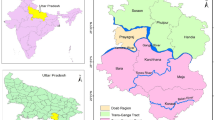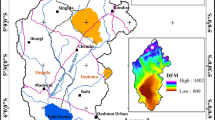Abstract
The study of changes and destruction rate in the previous years as well as the possibility of prediction of these changes in the following years has a key role in optimal planning, controlling, and restricting non-normative changes in the future. This research was approached to detecting land use/cover changes (1985–2007) and to forecast the changes in the future (2021) use of multitemporal satellite imagery in semi-arid area in western Iran. A supervised classification of multilayer perceptron (MLP) was applied for detecting land use changes. The study area was classified into five classes, those of forest, rangeland, agriculture, residential, and barren lands. The change detection analysis indicated a decreasing trend in forest cover by 30.42 %, while other land uses were increased during 1985 to 2007. The land use changes were predicted using Markov chain model for 2021. The model was calibrated by comparing the simulated map with the real detected classes of land cover in 2007. Then, for further model processing, an acceptable accuracy at 83 % was achieved between them. Finally, land use changes were predicted by using transition matrix derived from calibrated approach. The findings of this study demonstrate a rapid change in land use/cover for the coming years. Transforming the forest into other land uses especially rangeland and cropland is the main land cover changes in the future. Therefore, the planning of protection and restoration of forest cover should be an essential program for decision-makers in the study area.










Similar content being viewed by others
References
Agarwal, C., Green, G. M., Grove, J. M., Evan, T. P., & Schweik, C. M. (2002). A review and assessment of land use change models: dynamics of space, time and human choice, USDA (Forest Services). Technical Report, NE-297.
An, S., Zheng, F., Zhang, F., Van Pelt, S., Hamer, U., & Makeschin, F. (2008). Soil quality degradation processes along a deforestation chronosequence in the Ziwuling area, China. Catena, 75(3), 248–256.
Armenteras, D., Gast, F., & Villareal, H. (2003). Andean forest fragmentation and the representativeness of protected natural areas in the eastern Andes, Colombia. Biological Conservation, 113(2), 245–256.
Baker, W. L. (1989). A review of models of landscape change. Landscape Ecology, 2(2), 111–133.
Bell, E. J. (1974). Markov analysis of land use change-an application of stochastic processes to remotely sensed data. Socio-Economic Planning Sciences, 8(6), 311–316.
Brown, D. G., Pijanowski, B. C., & Duh, J. D. (2000). Modeling the relationships between land use and land cover on private lands in the upper Midwest, USA. Journal of Environmental Management, 59(4), 247–263.
Burnham, B. O. (1973). Markov intertemporal land use simulation model. Southern Journal of Agricultural Economics, 5(01), 253–258.
Dadras, M., Mohd Shafri, H. Z., Ahmad, N., Pradhan, B., & Safarpour, S. (2014). Land use/cover change detection and urban sprawl analysis in Bandar Abbas City. Iran. The Scientific World Journal, 2014.
Dzieszko, P. (2014). Land-cover modelling using corine land cover data and multi-layer perceptron. Quaestiones Geographicae, 33(1), 5–22.
Fan, F., Wang, Y., & Wang, Z. (2008). Temporal and spatial change detecting (1998–2003) and predicting of land use and land cover in Core corridor of Pearl River Delta (China) by using TM and ETM+ images. Environmental Monitoring and Assessment, 137(1–3), 127–147.
Faramarzi, M., Kesting, S., Isselstein, J., & Wrage, N. (2010). Rangeland condition in relation to environmental variables, grazing intensity and livestock owners’ perceptions in semi-arid rangeland in western Iran. The Rangeland Journal, 32(4), 367–377.
Gilks, W. R. (2005). Markov chain Monte Carlo. Ltd:John Wiley & Sons.
Guo, L. B., & Gifford, R. M. (2002). Soil carbon stocks and land use change: a meta analysis. Global Change Biology, 8(4), 345–360.
Hathout, S. (2002). The use of GIS for monitoring and predicting urban growth in east and west St Paul, Winnipeg, Manitoba, Canada. Journal of Environmental Management, 66(3), 229–238.
Jenerette, G. D., & Wu, J. (2001). Analysis and simulation of land-use change in the central Arizona–Phoenix region, USA. Landscape Ecology, 16(7), 611–626.
Jokar Arsanjani, J., Helbich, M., Kainz, W., & Boloorani, A. D. (2013). Integration of logistic regression, Markov chain and cellular automata models to simulate urban expansion. International Journal of Applied Earth Observation and Geoinformation, 21, 265–275.
Khormali, F., & Nabiollahi, K. (2009). Degradation of mollisols in western Iran as affected by land use change. Journal of Agricultural Science and Technology, 11, 363–374.
Kumar, U., Kerle, N., Punia, M., & Ramachandra, T. V. (2010). Mining land cover information using multilayer perceptron and decision tree from MODIS data. Journal of the Indian Society of Remote Sensing, 38(4), 592–603.
Lemenih, M., Karltun, E., & Olsson, M. (2005). Assessing soil chemical and physical property responses to deforestation and subsequent cultivation in smallholders farming system in Ethiopia. Agriculture, Ecosystems & Environment, 105(1), 373–386.
Mugagga, F., Kakembo, V., & Buyinza, M. (2012). Land use changes on the slopes of Mount Elgon and the implications for the occurrence of landslides. Catena, 90, 39–46.
Muller, M. R., & Middleton, J. (1994). A Markov model of land-use change dynamics in the Niagara Region, Ontario, Canada. Landscape Ecology, 9(2), 151–157.
Murthy, C. S., Raju, P. V., Jonna, S., Hakeem, K. A., & Thiruvengadachari, S. (1998). Satellite derived crop calendar for canal operation schedule in Bhadra project command area, India. International Journal of Remote Sensing, 19(15), 2865–2876.
Pal, Y., Gilkes, R. J., & Wong, M. T. F. (2001). Soil factors affecting the availability of potassium to plants for western Australian soils: a glasshouse study. Soil Research, 39(3), 611–625.
Pontius, G. R., & Malanson, J. (2005). Comparison of the structure and accuracy of two land change models. International Journal of Geographical Information Science, 19(2), 243–265.
Ramankutty, N., & Foley, J. A. (1999). Estimating historical changes in global land cover: croplands from 1700 to 1992. Global Biogeochemical Cycles, 13(4), 997–1027.
Rosenblatt, F. (1961). Principles of neurodynamics. perceptrons and the theory of brain mechanisms (no. VG-1196-G-8). CORNELL AERONAUTICAL LAB INC BUFFALO NY.
Rumelhart, D. E., Hinton, G. E., & Williams, R. J. (1985). Learning internal representations by error propagation (no. In ICS-8506). SCIENCE: California UNIV SAN DIEGO LA JOLLA INST FOR COGNITIVE.
Seto, K. C., Woodcock, C. E., Song, C., Huang, X., Lu, J., & Kaufmann, R. K. (2002). Monitoring land-use change in the Pearl River Delta using Landsat TM. International Journal of Remote Sensing, 23(10), 1985–2004.
Turner, B. L., & Meyer, W. B. (1991). Land-use and land cover in global environmental-change-considerations for study. International Social Science Journal, 43(4), 669–679.
Vance, C., & Iovanna, R. (2006). Analyzing spatial hierarchies in remotely sensed data: insights from a multilevel model of tropical deforestation. Land Use Policy, 23(3), 226–236.
Veldkamp, A., & Fresco, L. O. (1996). CLUE: a conceptual model to study the conversion of land use and its effects. Ecological Modelling, 85(2), 253–270.
Venkatesh, Y. V., & KumarRaja, S. (2003). On the classification of multispectral satellite images using the multilayer perceptron. Pattern Recognition, 36(9), 2161–2175.
Weng, Q. (2002). Land use change analysis in the Zhujiang Delta of China using satellite remote sensing, GIS and stochastic modelling. Journal of Environmental Management, 64(3), 273–284.
Wu, Q., Li, H. Q., Wang, R. S., Paulussen, J., He, Y., Wang, M., Wang, B. H., & Wang, Z. (2006). Monitoring and predicting land use change in Beijing using remote sensing and GIS. Landscape and Urban Planning, 78(4), 322–333.
Yuan, F., Bauer, M. E., Heinert, N. J., & Holden, G. R. (2005). Multi-level land cover mapping of the Twin Cities (Minnesota) metropolitan area with multi-seasonal Landsat TM/ETM+ data. Geocarto International, 20(2), 5–13.
Zhang, R., Tang, C., Ma, S., Yuan, H., Gao, L., & Fan, W. (2011). Using Markov chains to analyze changes in wetland trends in arid Yinchuan Plain, China. Mathematical and Computer Modelling, 54(3), 924–930.
Author information
Authors and Affiliations
Corresponding author
Rights and permissions
About this article
Cite this article
Fathizad, H., Rostami, N. & Faramarzi, M. Detection and prediction of land cover changes using Markov chain model in semi-arid rangeland in western Iran. Environ Monit Assess 187, 629 (2015). https://doi.org/10.1007/s10661-015-4805-y
Received:
Accepted:
Published:
DOI: https://doi.org/10.1007/s10661-015-4805-y




